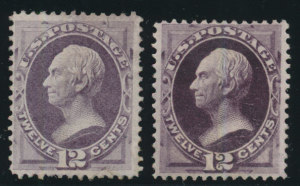Foreign collectors believe that collecting United States stamps is the most difficult of all national collecting specialties. The reason is that we make too many major catalog numbers of stamps on which the differences are very hard to distinguish. It starts with the one cent 1851’s of which there are seven major catalog numbers of a single design and color, but it really reaches its apotheosis with the Bank Note Issue beginning in 1870 (These issues are called the Bank Note issues because the the US Post Office changed its printing contract to award it to a printing company that also printed currency).
There are three main issues of Bank Notes along with numerous reissues and special printings and in all comprise nearly 60 major catalog numbers for eleven different stamp designs. The catalog does a pretty good job with an overview of the very subtle differences that distinguish these stamps. But take it from someone who has seen literally millions of them, in real life it is often not that easy to tell these stamp varieties apart with complete certainty, especially on the higher values where there is no different printing characteristics, and one must go only by shade. When the stamps are over inked or when the papers are a mixed hybrid like on some of the Continental printings determining the correct catalog number of these stamps can be trying indeed.
The difficulties with the Bank Notes, be clear, are not some cosmic problem that philately is eternally cursed with having to deal with. It is a man made problem, created by early US collectors who, as I read the literature of the period, seemed to be groping around for ways to make the hobby more scholarly and difficult in a belief that complexity could diffuse the charge that they were continuing a childhood hobby into adulthood. Their decision has had long lasting and deleterious effects on stamp collecting, making US philately unnecessarily obscure and off-putting. We still suffer from a lack of popularity among foreign collectors because of this and even ridicule as a nation that has encouraged a level of specious sophistication in our collecting that we wouldn’t tolerate in the philately of others.


